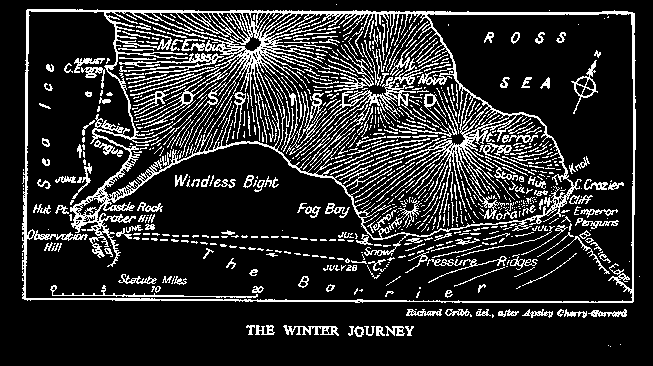In the World

Polar exploration is at once the cleanest and most isolated way of having a bad time which has been devised. It is the only form of adventure in which you put on your clothes at Michaelmas and keep them on until Christmas, and, save for a layer of the natural grease of the body, find them as clean as though they were new. It is more lonely than London, more secluded than any monastery, and the post comes but once a year. As men will compare the hardships of France, Palestine, or Mesopotamia, so it would be interesting to contrast the rival claims of the Antarctic as a medium of discomfort. A member of Campbell's party tells me that the trenches at Ypres were a comparative picnic. But until somebody can evolve a standard of endurance I am unable to see how it can be done. Take it all in all, I do not believe anybody on earth has a worse time than an Emperor penguin.
The Worst Journey
In the World
What was merely eccentric ninety years ago might better be characterised as fool-hardy. Even though the author appears to be loyal and true to Scott, as one reads The Worst Journey in the World, one gets the feeling that the whole kit-and- In his last journal entry, written as he was dying, Scott blamed the weakness of his companions, and the weather --- ignoring the fact that at exactly the same time the Norwegian Roald Amudsen succeeded in reaching the South Pole with no loss of life whatsoever. At no point did Scott take the blame on himself. Cherry seems to be somewhat ambivalent on the point. He noted that no dogs were used in Scott's expedition, and pointed out that thirty pounds of "geological specimens" was added to the sledge that was supposed to return the men safely from the pole. But then Cherry quickly adds, The implication stands that Scott was not "a practical man." Indeed, as we read about him here, we are left with the impression that Scott had a very diffuse vision, and, was, if you will pardon the expression, a very chilly man, even before his last fatal trip made him colder than ever. What truly tested Cherry, and gives us some of the most fascinating parts of The Worst Journey in the World, is the "side trip" that he and two of his companions took in the winter of 1912, to the base of the well-named Mount Terror. It was, ostensibly, an exploration to get eggs of the Emperor Penguin: but like so many of the misadventures that befell Scott and his companions, it was a journey so fraught, so impossible, so dreadful, so achingly cold, that Cherry labeled it (rather than the main expedition) The Worst Journey in the World. In this way, he seemed, long after the fact, to be protecting Scott, not dwelling on the myriad foolish decisions which caused his death.
The practical man ... doesn't know that these specimens dated a continent and may elucidate the whole history of plant life...and declares that Amundsen was perfectly right in refusing to allow science to use up the forces of his men, or to interfere for a moment with his single business of getting to the Pole and back again. No doubt he was; but we were not out for a single business...